I'm a kinkajou and this is my photo album! You might be wondering what a kinkajou is, so I put a recent picture of myself up on the first page. Our scientific name is Potos flavus. We are relatively small omnivores, which means we eat both plants and other animals. Weighing 1.5 to 3.5 kilograms, we can grow to be from 43 to 56 cm, head and body, with a tail of the same size. We have large brown eyes and small, round ears. We also posess very long tongues, sharp claws, and pointed teeth, which are all used to ensure our balanced diet of fruits, leaves, flowers, small mammals, insects, birds, and honey. You will get to see pictures of this later on in my album.
Kinkajous have golden, short, thick fur covering all parts of our bodies except our scent glands on our throats, jaws, and stomachs. Since we have poor vision and cannot differentiate between colours, we rely on our heightened senses of touch and smell to communicate and understand. Other methods of communication between ourselves include chittering and screaming; and when I'm really excited about something, I will make kissing noises.
While we look like primates, kinkajous are in fact a close relative of raccoons. We are nocturnal animals who sleep in tree holes during the day and spend our nights hunting and eating.
We are classified as follows:
- Kingdom: Animalia
- Phylum: Chordata
- Class: Mammal
- Order: Carnivora
- Family: Procyonidae
- Genus: Potos
- Species: Potos flavus
This is me at birth.
I was born in a dark den because it takes baby kinkajous a while to learn how to live in the trees. For the first month, I could not see as I was born with my eyes closed, but once I began to mature things happened very rapidly.
This is me hanging by my tail for the first time.

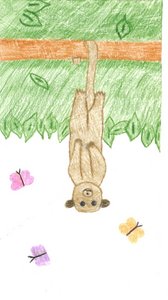
Kinkajou hanging by its tail. © Megan Cross
By the age of two months, I was able to hang by my tail, meaning I started spending all my time in tree canopies. I love it up here! Us kinkajous like to live in all the tropical rainforests of Central and South America just like this one.
This is me when I left home.

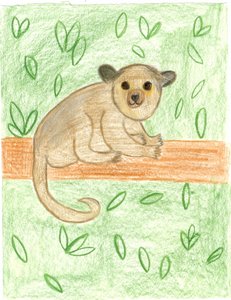
Kinkajou in a tree. © Marie-France Lavoie
After four months I was old enough to walk on my own and not be carried by my mother. When I reached the age of one and a half and became old enough to mate I left my mother and started my own life.
This is a picture someone took of the time I got chased by a jaguar.

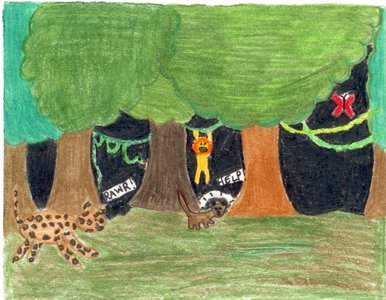
Kinkajou being chased by a jaguar. © Marie-France Lavoie and Megan Cross
We are an endangered species, mostly due to a loss of habitat caused by the deforestation of forests. Other reasons include capture to become pets, poaching by humans for meat and fur, and our natural predators such as foxes, jaguars, and ocelots. I'm lucky to still be alive!
This is me having a midnight snack.

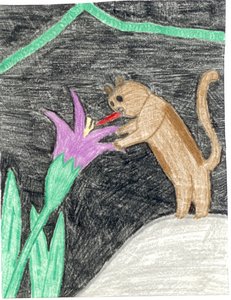
Kinkajou sucking nectar from a flower. © Megan Cross
I love flower nectar! We kinkajous play a very important role in the ecosystem of the tropical forests because we are pollinators who also help with seed dispersal. To get nectar I have to suck it out of the flower with my very long tongue. During this process we get pollen all over our faces, which we end up spreading to the next flower we eat from. I have also spread a few seeds around in my lifetime. When I come in contact with some plants I get seeds on me and eventually end up spreading them. I don't even realize when it happens.
This is me with one of my favourite meals.

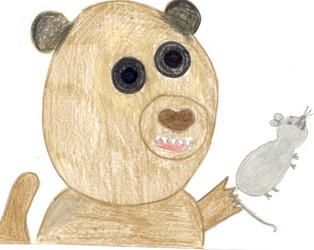
Kinkajou eating a mouse. © Marie-France Lavoie
We have a lot of neat body parts that help us within our environment, such as our sharp claws which we use to hunt smaller mammals (as in this picture). We also have very long, prehensile tails, which we use as a fifth limb to hang from trees as you saw, keep our balance, and keep us warm at night. Our paws and long, skinny tongues make getting food easier. Something really unique about us is that we have reversible feet! We can turn them backwards to move swiftly and nimbly in either direction, and through the trees.
This is when I met my girlfriend, Igna. It was love at first sight!


Kinkajou with its mate. © Marie-France Lavoie and Megan Crosscreature%2039
Male kinkajous reach sexual maturity at approximately 1 and a half years, while females take two years. While some of us live in families, we are often solitary animals and do not live in big groups. A lot of my friends only want to come into contact with others when mating. I prefer to stay with Igna all the time because she is pregnant. After 112 to 120 days we are going to have a baby, or kit. Although twins are possible, kinkajous usually give birth to only one offspring at a time, not a litter. I'm really excited!! Igna and I have no idea how long we will live since we're endangered, but hopefully we will be able to watch our child grow up. I once heard of a kinkajou who lived to be 23 years old! I hope we make it that long!

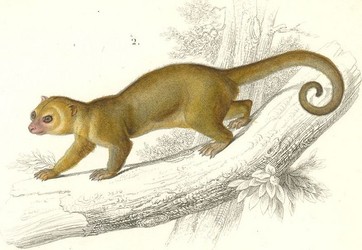
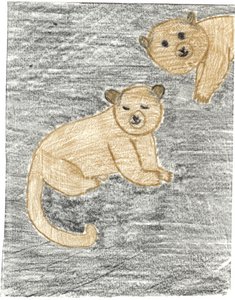


 Go to quick links
Go to quick search
Go to navigation for this section of the ToL site
Go to detailed links for the ToL site
Go to quick links
Go to quick search
Go to navigation for this section of the ToL site
Go to detailed links for the ToL site